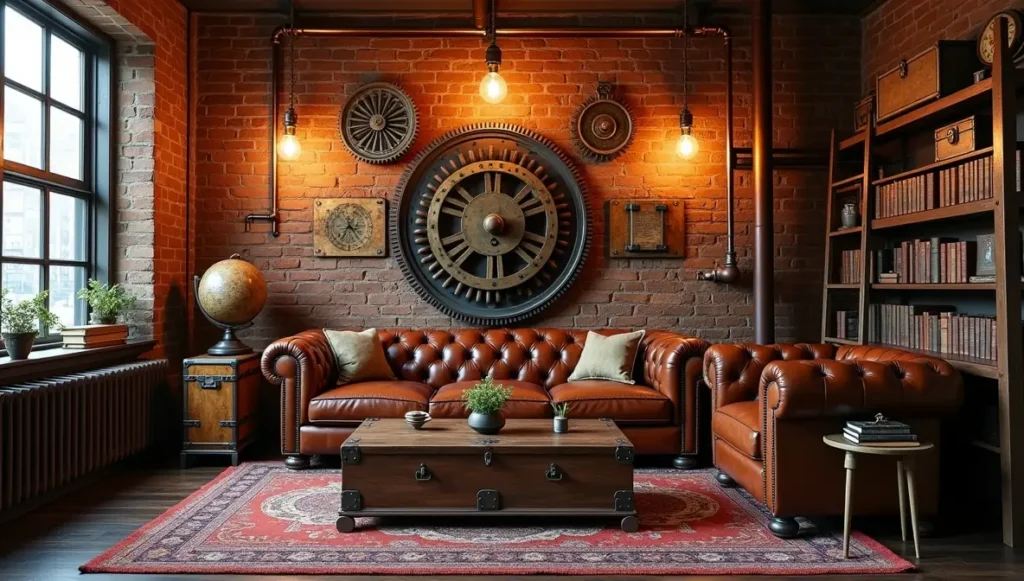- Steampunk Interior Design: What Happens When Victorian Inventors Meet Your Living Room - September 6, 2025
- Tuscan Interior Design: Creating That Effortless Italian Villa Look - September 2, 2025
- The Real Deal on Eclectic Interior Design (From Someone Who’s Actually Done It) - September 1, 2025
Table of Contents
Victorian elegance paired with raw industrial machinery – that’s what makes steampunk interiors so captivating. I love how designers take these two opposite worlds and somehow make them work together perfectly. Picture ornate wooden pieces surrounded by copper tubing and intricate gears – it creates this amazing contrast that shouldn’t make sense but absolutely does.
This style really comes from all those fantastic old books about incredible adventures and wild inventions. We’re talking about stories with massive underwater vessels, complex time machines, and aircraft powered by steam engines. When you bring these ideas into interior design, something really special happens. Each brass fitting and mechanical detail starts to feel like it belongs to a larger story – maybe your dining room doubles as a Victorian scientist’s laboratory.
Look, I’m gonna be straight with you. Most people think steampunk means hot-gluing some gears to a picture frame and boom, you’re done. That makes me want to scream.
I fell into this world completely by accident in 2012. Had this client in Chicago who owned this insane 1890s warehouse. Original brick walls, massive iron beams, windows tall enough to make you dizzy. She was obsessed with those old adventure novels and wanted her place to feel like “what Victorians thought 2020 would look like.”
Took me three months to figure out what the hell she meant.
Turns out, she wanted something that felt like stepping into an alternate universe where steam never died, where everything was brass and leather and built by hand. Where inventors wore top hats and airships ruled the skies.
That project broke my brain in the best possible way.
Why Most Steampunk Rooms Look Like Garbage
Here’s the problem: everyone focuses on the wrong stuff. They see “steampunk” and think it’s about cramming as many gears as possible into one room. Wrong.
The Victorians were obsessed with showing off wealth through beautiful objects. They loved visible mechanics because machinery was the coolest thing happening. Everything had to look purposeful, even if it wasn’t.
So when I design steampunk spaces now, I ask: would this impress a Victorian inventor? Does it look like it could actually do something? Or does it just look like I raided a craft store?
Real steampunk feels like you’re in the workshop of someone brilliant and slightly mad. Every piece should tell a story.
Colors That Don’t Suck
Forget what you think you know about “industrial” colors. Steampunk isn’t about cold grays and harsh whites.
Start with rich browns. Deep chocolate, warm cognac, that perfect leather color that gets better with age. These make rooms feel expensive and lived-in.
Add some drama with burgundy. Not bright red, burgundy. The color of expensive wine or old library chairs. Forest green works too, especially in leather or heavy fabric.
Navy blue shows up in Victorian spaces constantly. It’s sophisticated without being boring.
But here’s the secret: the metals make everything work. Brass everywhere. Copper pipes that actually look like they belong there. Bronze details that catch light perfectly. Aged iron that looks hand-forged.
Stay away from chrome or stainless steel. Too modern, too cold. Wrong century entirely.
Materials That Actually Matter
Leather: This isn’t fake pleather from discount stores. We’re talking thick, rich leather that smells amazing and gets more beautiful with age. Deep browns, burgundy, forest green. The kind of leather that made Victorian gentlemen feel important.
Wood that has character: Mahogany, walnut, cherry. Dark woods that look like they came straight out of some expensive private library. Not that rustic farmhouse look, not weathered beach house stuff. Refined, solid, built-to-last-forever wood.
The right metals: I really can’t emphasize this enough. Brass, copper, bronze. Metals that look like they were crafted by someone who actually cared about their work. A little patina is perfect. Too much shine makes me suspicious.
Fabrics that feel expensive: Heavy brocades, rich velvets, substantial cottons. Everything should feel like it cost way too much money but was completely worth every penny.
Room by Room (Without Losing Your Mind)
Living Rooms That Don’t Look Like Museums
Start with one incredible leather sofa. Chesterfield style if you can swing it, with those button details and rolled arms. Deep brown or burgundy. This is your anchor piece, so don’t cheap out.
Add a wingback chair that looks like where a Victorian inventor would sit to sketch crazy contraptions. Maybe two if your room’s big enough.
Coffee tables are where you can get weird. I’ve made tables from old printing press parts, vintage machinery bases, custom pieces with actual working clockwork. The trick is making it look functional, not random.
Side tables can incorporate mechanical stuff without going overboard. Maybe legs that look like they came from old factory equipment, but refined enough for a Victorian parlor.
Lighting has to feel warm. Edison bulbs in brass fixtures. Table lamps that look substantial. Floor lamps with pipe elements or mechanical details. Nothing minimal, nothing stark.
Paint colors matter more than you think. Deep colors work better than light ones. Consider wallpaper with subtle mechanical patterns or damask designs.
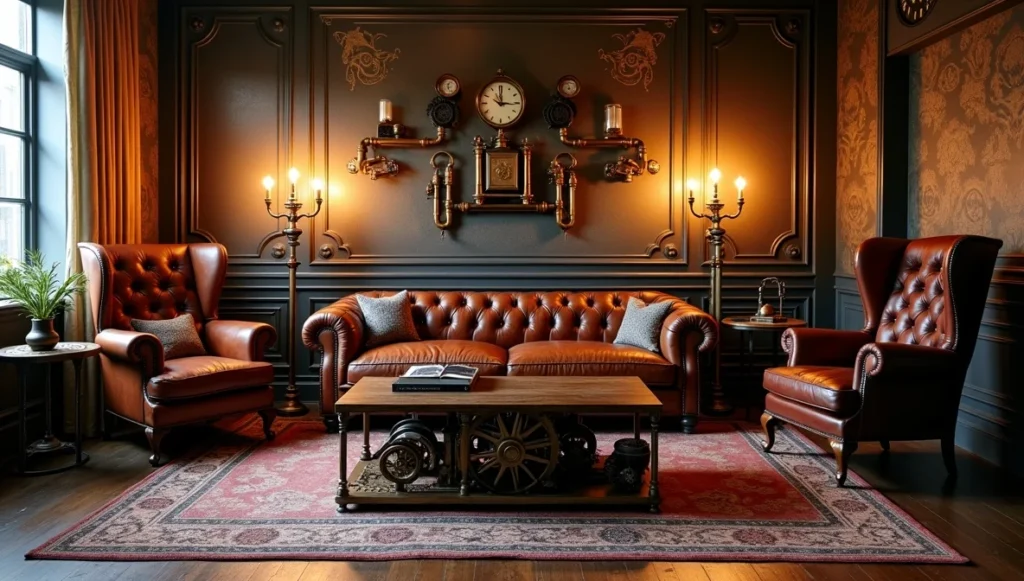
Kitchens for Mad Scientists (Who Actually Cook)
This is the trickiest room because you need modern appliances that don’t ruin the vibe.
Cabinets should be dark and substantial. Rich mahogany or walnut stains. Hardware in brass or copper with mechanical details. Look for handles that incorporate gear elements but don’t look like costume jewelry.
Hide modern appliances whenever possible. If you can’t hide them, consider custom panels or modifications. I’ve had ranges painted to look like old factory equipment. Sounds crazy but works incredibly well.
Backsplashes can use subway tiles in warm colors, copper sheeting, or custom metalwork. Exposed pipes are your friend here, especially painted in brass or copper tones.
Countertops need substance. Butcher block in dark wood, natural stone in warm colors, even copper surfaces if you’re feeling adventurous.
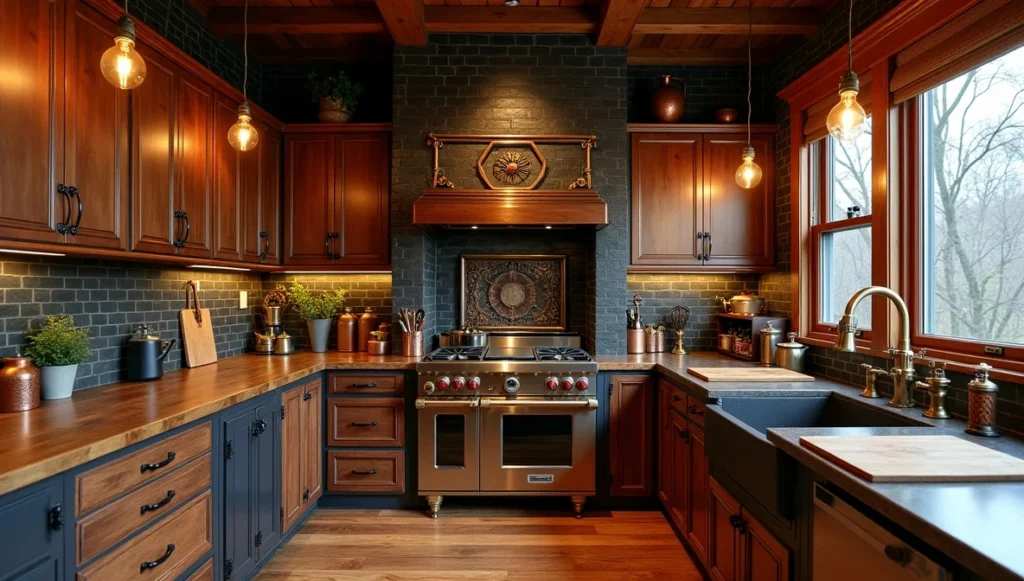
Bedrooms for Adventurous Victorians
Iron bed frames with mechanical details are perfect. Or substantial wood frames with brass hardware. Nothing delicate or minimalist.
Bedding should feel luxurious but not precious. Heavy fabrics in rich colors. Layer different textures: velvet throws, leather pillows, maybe a vintage-style quilt.
Steamer trunks make perfect bedroom storage while staying in character. Substantial wooden armoires with brass fittings. Maybe a writing desk where your fictional Victorian inventor plans their next expedition.
Bedside lamps with brass bases and warm bulbs. Maybe incorporate some clockwork elements as decorative features, but don’t go nuts.
One accent wall in deep color or with mechanical-inspired wallpaper can add drama without overwhelming the space.

Home Offices Where Great Ideas Happen
This is where steampunk really shines. Your desk should look like where world-changing inventions happen.
Look for pieces that incorporate mechanical elements naturally. Desks with visible gear systems, bases made from repurposed industrial equipment, anything that looks functional rather than decorative.
Desk chairs need to be comfortable enough for real work but maintain the aesthetic. Leather in rich colors works best. Look for pieces with mechanical adjustments or brass fittings.
Storage gets to be both functional and theatrical. Vintage-style file cabinets, industrial shelving, custom pieces that look like laboratory equipment.
Task lighting is crucial. Desk lamps with brass bases and adjustable arms. Maybe pendant lights that look like they came from old factories.
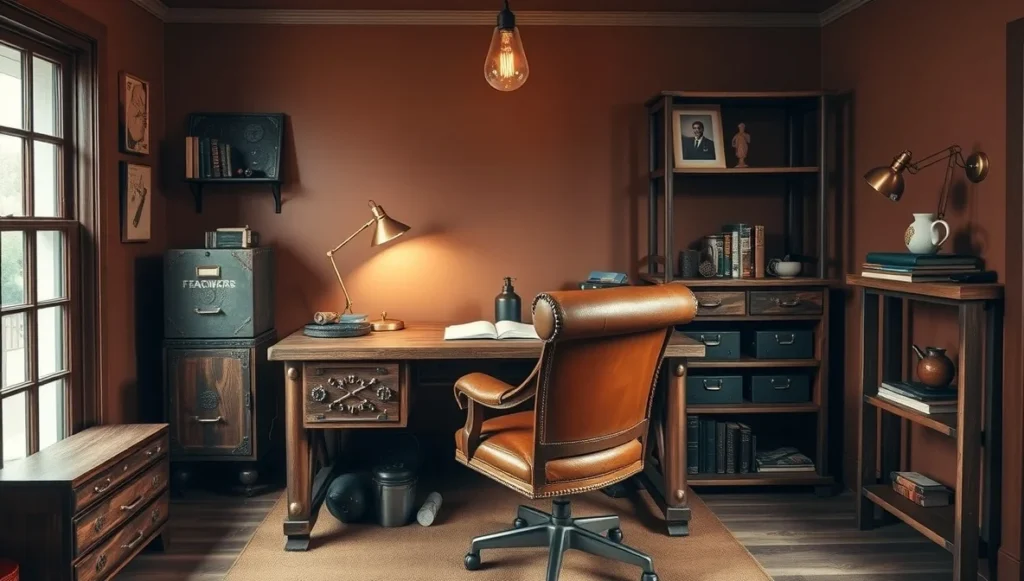
Bathrooms That Don’t Embarrass Your Victorian Ancestors
Clawfoot tubs are perfect, especially cast iron with brass fittings. Pedestal sinks with brass fixtures maintain the period feel.
Here’s the thing about bathrooms: don’t hide the plumbing. Exposed pipes become part of the design when they’re properly finished in brass or copper.
Vanities should look like substantial furniture pieces, not modern floating cabinets. Dark wood with brass hardware, maybe incorporating some mechanical details.
Mirrors with brass or iron frames. Lighting should be warm and flattering: brass sconces or fixtures with Edison bulbs.
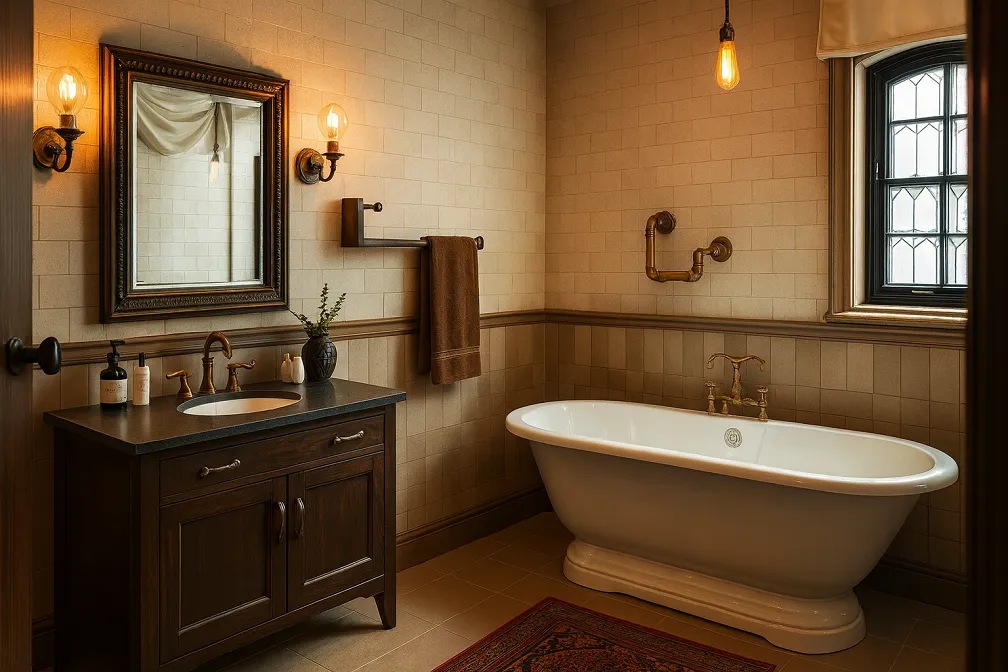
What Kills the Vibe Every Time
Random gears everywhere: Stop gluing clock parts to everything. Mechanical elements should look like they serve a purpose, even if they don’t.
Wrong century metals: Chrome belongs in modern spaces, not steampunk ones. Stick with brass, copper, bronze, aged iron.
Cheap costume crap: Those plastic “steampunk” accessories from party stores look exactly like what they are. Invest in quality pieces or good reproductions.
Forgetting comfort: Victorians liked comfortable furniture. Your steampunk spaces should be places you actually want to hang out.
Missing the elegance: This isn’t just industrial design with extra steps. Victorian refinement is half the equation.
Making It Work Without Going Broke
You don’t need to gut your entire house to embrace steampunk elements. Start with a few key pieces and build from there.
Good leather furniture is worth the investment. Quality wood pieces that can handle mechanical modifications. Proper lighting that creates the right atmosphere.
Focus on materials and finishes first. A cheap piece in the right finish looks better than an expensive piece in the wrong one.
The best steampunk spaces feel like they evolved over time. Like someone interesting lived there and collected fascinating objects from their adventures.
Think about the story your room tells. Who lives here? What do they invent? What adventures have they been on? Every piece should fit that narrative.
Don’t try to do everything at once. This style works best when it feels collected and curated, not bought all at once from some steampunk furniture store (which doesn’t exist anyway).
